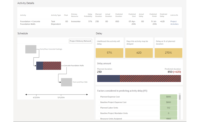It has been a long journey since Australia-based construction management software maker Aconex was acquired by Oracle last December in a $1.2-billion deal. Aconex has taken seriously a mandate from Oracle to increase its interoperability with the company’s other platforms, and is building out its offerings for supply-chain monitoring and analytics.
“Our products are stronger since then, but we now have a thesis on how it will all fit together,” says Leigh Jasper, CEO of Aconex. “There’s a strong complimentary nature in these products, with these big data sets. We’re getting scheduling data alongside payment data and construction data—the opportunities are endless.”
Jasper’s strategy reflects a broader push within Oracle to better share data across its construction products, including Primavera and Textura. Oracle realizes there is still much to be gained by providing better integration between its platforms without forcing big changes in how they function, says Mike Sicilia, senior vice president and general manager for Oracle Construction and Engineering.
“I’m not a big believer in tightly coupling everything together from a data standpoint,” he told ENR. “The best way to bring these systems together is through composite analytics.” Oracle plans to launch, sometime in 2019, a cloud-based analytics platform that compiles data sets from different Oracle products, says Sicilia.
In addition, Jasper says Aconex was already working on supply-chain data before the deal, and sees it as key to better overall analytics. “We’re working with Textura so we can track manufacturers. There’s a big data opportunity there. We’re getting all this data in one place, and you start to see how it changes how you do business. No one has 100% of the data puzzle, but these are the big pieces.”




Post a comment to this article
Report Abusive Comment